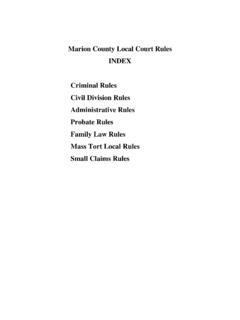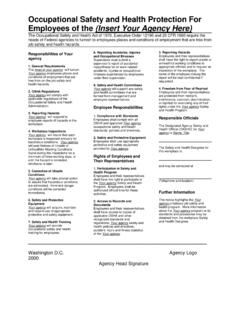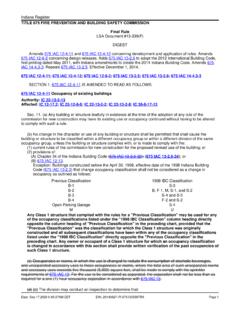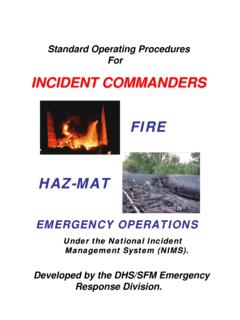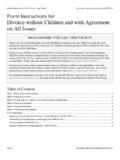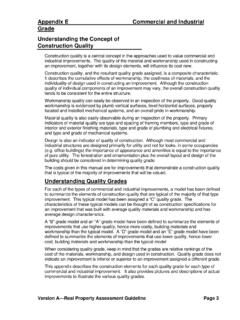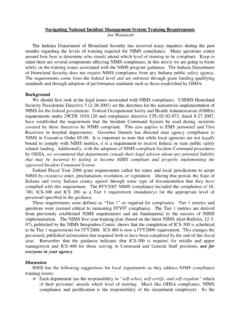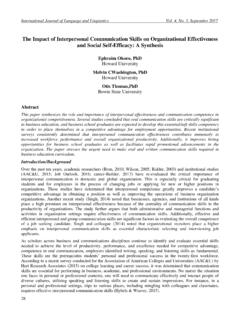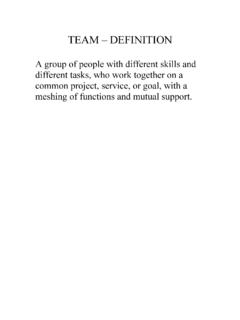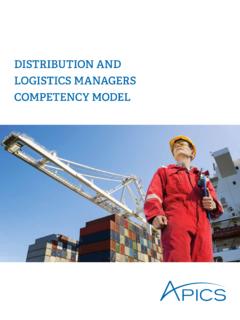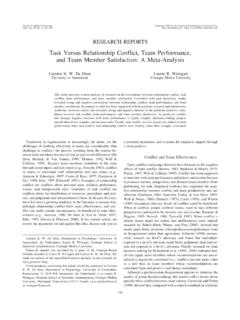Transcription of Identifying Community Strengths & Weaknesses
1 A Capacity Building Workshop by OCRA & IHCDA Identifying Community Strengths & Weaknesses Presented by HPG Network S-W-O-T Self-Assessment A SWOT is the first step in a typical planning process What is a Plan? Sequence of steps Method of getting to your goal Recipe for action Image of the future as you hope it will unfold MORE THAN JUST TALK! Why is Planning Important Clarify choices Let everyone know what happens next Avoid or anticipate difficulties Provide inspiration Why is Planning Important Clarify choices Let everyone know what happens next Avoid or anticipate difficulties Provide inspiration Clarify Choices Know what paths you did NOT choose and why Consider various different ideas and solutions Build a foundation for commitment Why is Planning Important Clarify choices Let everyone know what happens next Avoid or anticipate difficulties Provide inspiration Let Everyone Know What Happens Next This keeps individuals plugging away Provides basis for teamwork Be sure to include timelines & guidelines for implementation Why is Planning Important Clarify choices Let everyone know what happens next Avoid or anticipate difficulties Provide inspiration Avoid or Anticipate Difficulties Shortages of money Uncooperative groups.
2 Officials, residents Planning helps to anticipate, avoid or work around identified issues Why is Planning Important Clarify choices Let everyone know what happens next Avoid or anticipate difficulties Provide inspiration Provide Inspiration Everyone knows the sequence of activities is leading toward a goal that is important to the group Plan becomes a source of inspiration Provides assurance that it s all going somewhere Periodically calls for re-assessments that may be perfect opportunities for celebration Planning Best Practice Tip Include a schedule for future updates to the planning document in order to keep it fresh Find your latest update to your Community plan & decide when it should be revisited. Overview of a Typical Planning Process Typical Planning Cycle Preparation for SWOT Analysis SWOT Analysis Visioning Plan Creation Implementation Check-ins / Revisions to the Plan Preparation for the SWOT Define/Refresh Data Related to Existing Conditions That Are Affecting Your Community Review Past Plans Important step Time saver Excellent baseline data to show where the Community has been Economic Factors Affecting Communities Economic conditions Population characteristics Labor force characteristics Physical conditions Business climate Knowledge-based resources Quality of life Economic Conditions Unemployment Types & sizes of firms/industries Wages Income New business starts Retail sales Housing prices Assessed valuation Types of imports/exports # of businesses closed A Brief Note On Assessed Valuation Population Characteristics Population size Population growth Age
3 Education level Education attainment & k-12 public school enrollment Population Analysis Tip Break down population growth into categories to better understand which part is growing or declining Labor Force Characteristics Labor force participation Occupation Skills Commuter characteristics productivity Per capita income Physical Conditions Land use Zoning Land values Condition of buildings Vacancy rates Building activity Parking facilities Condition & capacity of infrastructure Air/water quality Business Climate Community attitudes Labor relations Business taxes and regulations Level & quality of municipal services Workforce training Access to & cost of capital Public & private infrastructure Knowledge-based Resources Federal labs Science & research parks Industry incubators Colleges & universities Technical training schools Quality of Life Housing availability Public services Education system Crime rate Cultural & recreational activities Parks & other natural amenities Make a list of other types of data and/or analysis you need for your data refresh.
4 Typical Planning Cycle Preparation for the SWOT SWOT Analysis Visioning Plan Creation Implementation Check-ins / Revisions to the Plan Engagement is Key Works best when you have established a regular communication process so that relationships & trust grow & strengthen over time Community Engagement Considerations What level of participation are we seeking? Who are my primary stakeholders? Communications / materials Resources Time limitations Timely feedback & next steps Methods Tools for Community Engagement Surveys photography, poetry, artwork Community Mapping Modeling Public Meetings, Charrettes Workshops & Focus Groups Forums Social Media / Web-based Engagement Outdoor displays / idea walls / graffiti walls Get Input from Stakeholders Factors within & outside of the control of local government that impact & shape the local economy Identify Strengths & opportunities Don t forget about Weaknesses & threats Know Your Community See how it fits into the broader region Local economic success depends on regional economic success Questions to Ponder What industries in your Community & region are growing?
5 Struggling? What are the skills of your workforce? Are they sufficient to meet the needs of businesses? More Questions to Ponder What barriers & support services exist for local entrepreneurs & small businesses? Is the local & regional housing stock diverse enough to provide for a wide range of housing needs? If someone were to come to your Community tomorrow, what would they find attractive? Unattractive? Result of This Process? Stronger sense of your unique local assets What you can & should be doing to build on Strengths & mitigate Weaknesses Make a list of stakeholders you would like to engage for your Community planning processes. How To Identify Your Community s Strengths & Weaknesses Think of a Community problem that you believe needs to be resolved Why Identify Strengths & Weaknesses ? Develop a shared understanding of the problem(s) you re trying to deal with Raise the level of awareness about root causes of identified problem(s) Identify root causes DEVELOP YOUR ANALYSIS Question & Answer Approach Question-and-Answer Approach What is the main problem that concerns our Community ?
6 Why is that a problem? Repeat until root causes become apparent Who/what causes the problems? How? Question-and-Answer Approach What would it take to really eliminate the problem? Is this an individual/institutional problem or is it a systemic problem Question-and-Answer Approach What are our leverage points of potential influence over these powerful groups/institutions? How can our Community tie into this situation in a powerful way? Write down your conclusions using this Q & A approach. Exercise in Analytical Thinking Let s try looking at someone else s problem Analytical Thinking Problem: many people in our Community live in sub-standard housing perhaps as many as 15% Possible Causes Residents are too poor to afford any better housing Local officials turn their backs on code violations Landlords more concerned about profit than building maintenance Banks have redlined certain neighborhoods so that improvement loans aren t available Analytical Thinking Possible causes focus on Who should we go to get some leverage on the problem Choose a possible cause and analyze how you might go about solving it Possible Causes Residents are too poor to afford any better housing Local officials turn their backs on code violations Landlords more concerned about profit than building maintenance Banks have redlined certain neighborhoods so that improvement loans aren t available Things to Consider What are some possible explanations of the reasons for the problems?
7 How do you choose among competing explanations? What factual information will be relevant? Things to Consider (cont d) What can you do when members of your Community disagree about explanations? How could you raise these analysis questions during the meetings & day-to-day functioning of your planning group? Who can be a resource? Who would be a great partner? SETTING UP YOUR SWOT How to Conduct a SWOT Analysis Disclaimer It s really not a true analysis, it s a brainstorming session Do not discuss each item that someone wants to add to the list Add each item to the list without evaluation The truth-telling session will begin later Facilitator Experienced in running meetings Slightly knowledgeable about issues or willing to become so in preparation for the session Strong enough to keep the meeting from bogging down in discussion Stay away from anyone with a dog in the fight Consider your OCRA Community liaison Resources Needed Recorder (could also be facilitator)
8 Big chart Easel or wall that can accept sticky paper Lots of paper Conducting the SWOT Order steps with the acronym S-W-O-T Allows you to begin with Strengths Insist as many entries as people can think of for each category Be prepared for pauses Facilitation Tips No Strengths = categorically untrue No Weaknesses = threat may be apathy or lack of watchfulness Get through the brainstorming as quickly as possible if some analysis can be done later Analysis = look for connections between items listed Facilitation Tips Note connections between Strengths & Weaknesses Note connections between Opportunities & Threats Look at both internal & external factors Include items that can be controlled & factors that cannot be controlled Facilitation Tips Think of your Community as being in a competition just as a private business would do Relative success at economic development, housing, Community organizing, safety & beautification will point to success overall Following the SWOT If time is short, ask everyone to decide on most important single Community S, W, O or T If time is more abundant, ask people what surprised them most about the SWOTs listed Ask group to discuss where research & fact-finding are needed Following the SWOT Assign each SWOT point to a committee for further study or action Be sure to publish results or hold a follow up event for wider & additional discussion Next Steps in the Planning Cycle Preparation for the SWOT SWOT Analysis Visioning Plan Creation Implementation Check-ins / Revisions to the Plan Internal Scan SWOTs Can Also Be Conducted Internally INTERNAL Environmental Scan Workshop 70 Internal Environmental Scan Objectives 1.
9 Gauge the current conditions in the organization that may impact success in achieving strategic goals Internal Environmental Scan Objectives 2. Engage key internal stakeholders (YOU!) in the process of Identifying organizational Strengths and limitations 72 Internal Environmental Scan Objectives 3. Ultimately build a sense of urgency around change and improvement to meet our challenges 73 74 Strategic Planning Values Vision Mission Strategic Priorities SMART Goals 75 Anytown, IN Core Values Integrity/Honesty Family Commitment Helpfulness Responsibility/Accountability Cooperation 76 Anytown Vision Statement: Commitment to Community 77 Mission Statement The mission of Anytown is to exhibit integrity of service with a commitment to provide: Exemplary public safety Inviting parks and recreational opportunities Compassionate public assistance Responsible historic preservation of cemeteries and other Towns assets 78 Environmental Scans Objectives To gauge current conditions internally and externally of Strengths /opportunities that will help us achieve our strategic plan, or Weaknesses /threats that may impede us from achieving our strategic plan (establish a sense of urgency) To engage internal and external stakeholders (create a guiding coalition) In preparation to develop a realistic strategic plan (create a clear shared vision)
10 79 Strategic Planning Values Vision Mission Strategic Priorities SMART Goals 80 ENVIRONMENTAL SCANS 81 Environmental Scan Structure Use consensus to reach rating decisions Determine whether each factor is a strength or weakness A strength is helpful in reaching our objectives A weakness is harmful to reaching our objectives 82 Environmental Scan Structure Use definitions for each factor Determine how critical this factor is in achieving our objectives 83 Environmental Scan Scoring Categories Human Capital organizational Capital Knowledge Capital Resources / Ability to Provide Excellent Services Work Processes Human Capital Hiring (timely) qualified employees Training employees organizational Capital Structure Governance teamwork Resources Asset Management Work Processes Efficiency Producing desired results Exceeding customer wants, needs, and values How Critical Is The Function?

